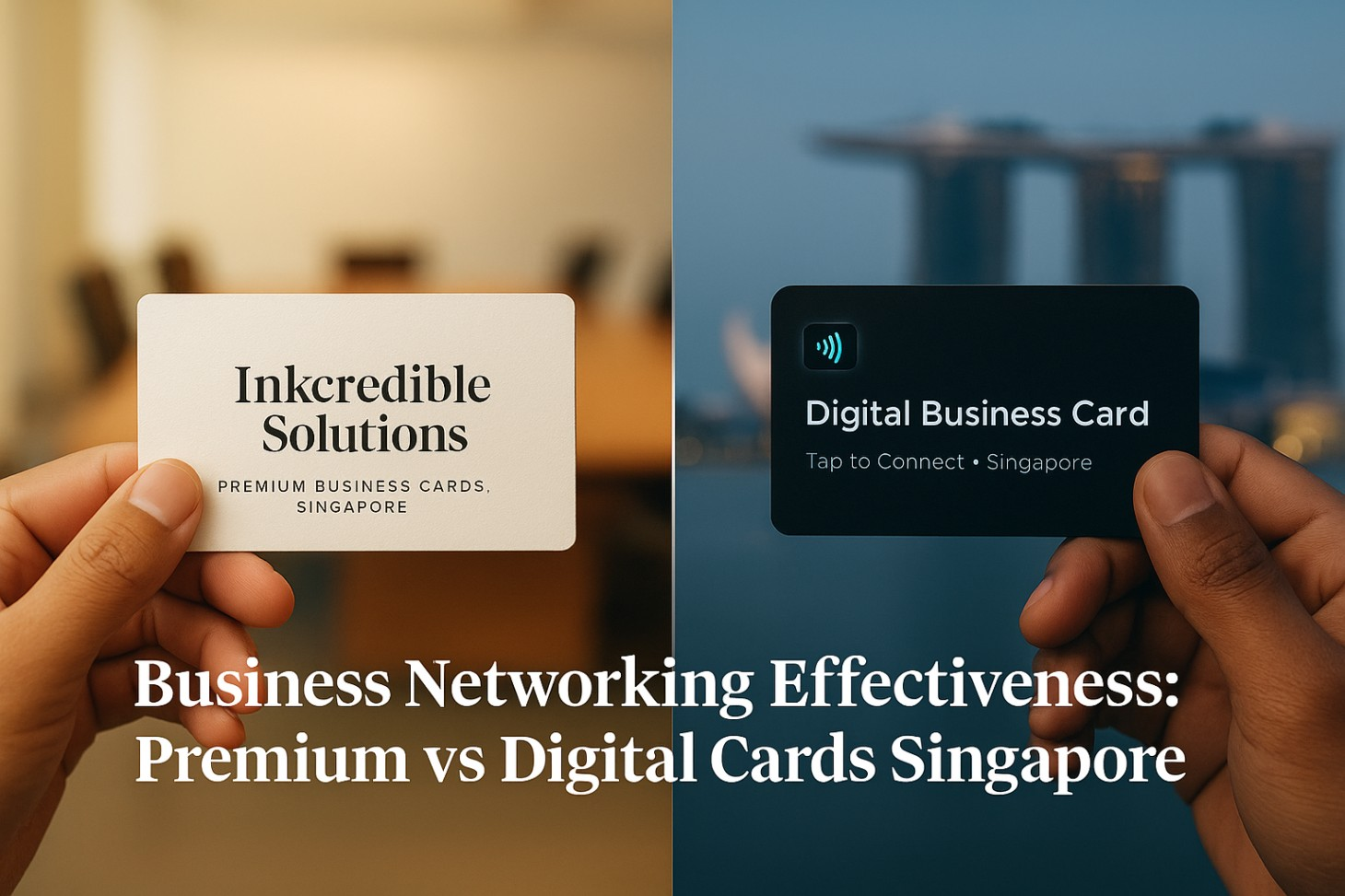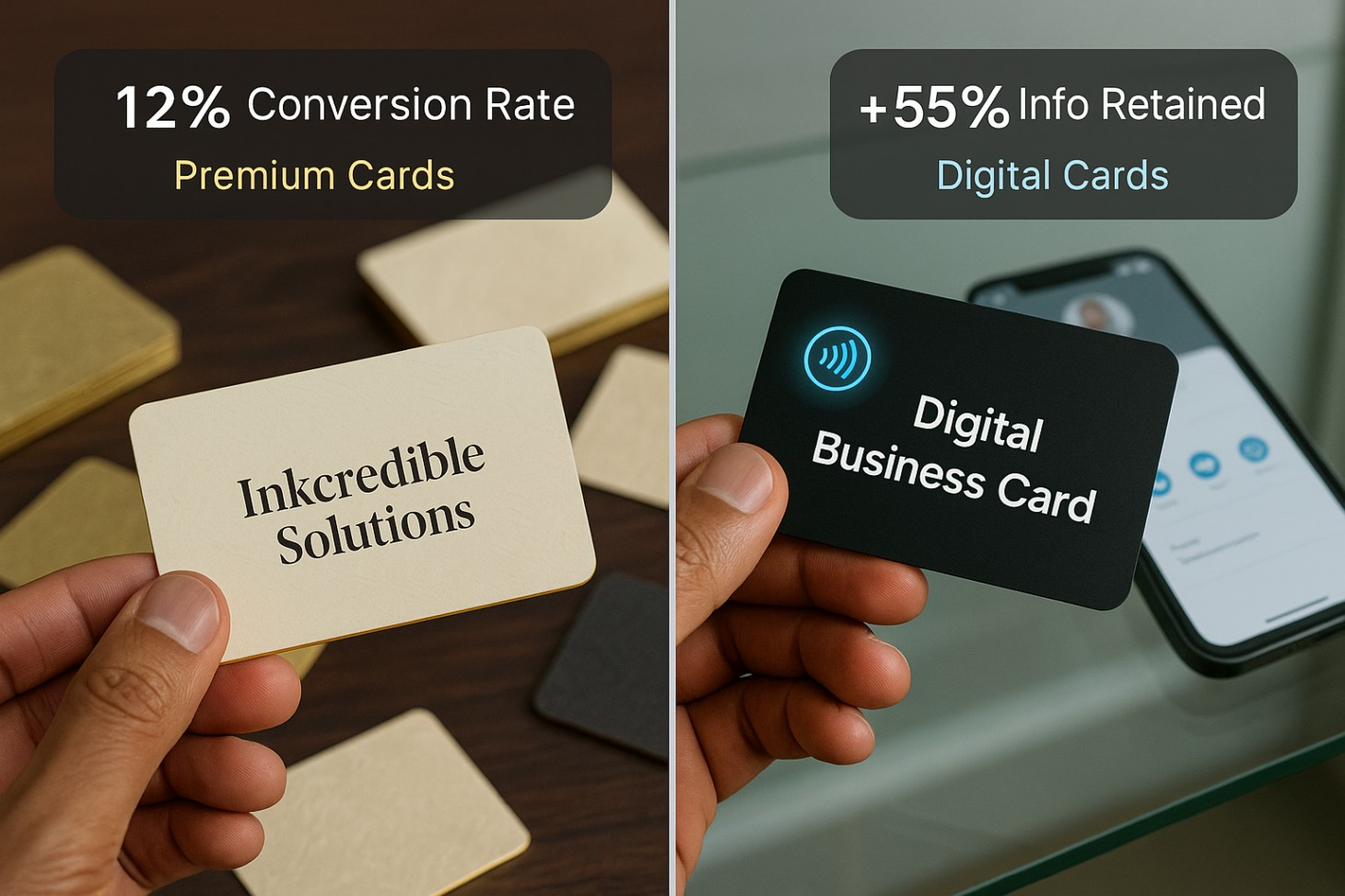
Business Networking Effectiveness: Premium vs Digital Cards Singapore
June 25, 2025
These days in Singapore’s fiercely competitive business world, the classic debate between old-school premium business cards and sleek digital versions is more alive than it has ever been. Even as tech-savvy executives race to adopt NFC-enabled cards and QR codes, there is still something about a thick, gold-edged business card that earns instant respect in the boardroom. Knowing when to use each type of card can make all the difference in how you connect and present yourself in Singapore’s business scene.
Why Business Cards Are Still a Big Deal in Singapore
In Singapore, business still revolves around personal connections, and those all-important first impressions can make or break a deal. Even in a city as wired as Singapore, first impressions remain old-school: nearly three-quarters of people judge a brand just by its business card, and almost four in ten will reconsider working with anyone whose card looks flimsy or cheap. This psychological effect is even stronger in Singapore’s business world, where hierarchy matters a lot. Here, showing respect for seniority and presenting yourself professionally are not just nice touches; they are essential to being taken seriously.
Business cards still pack a punch when it comes to conversions, boasting a 12% conversion rate, which towers over the average website’s modest 2.35%. In Singapore, where business is built on relationships, handing someone a physical card leaves an impression that digital exchanges simply cannot match. For every 2,000 business cards handed out, sales jump by 2.5%, which proves that smartly distributing cards remains a budget-friendly way for Singapore companies to drive growth.

Premium Printed Cards: Prestige You Can Feel and Cultural Meaning
Why Premium Materials Leave a Lasting Impression
There is something about a premium business card that triggers a reaction in people which digital versions simply cannot match. There is something unforgettable about the feel of thick, textured cardstock in your hand; it leaves an impression that sticks with you and makes the brand much easier to remember. When a business card is made from premium materials, people instinctively see it as more trustworthy and reliable. The heft and texture quietly send a message of quality and substance.
In Singapore, where business culture has a flair for the luxurious, the type of material you choose for your business card says a lot more than you might think. There is a certain heft to heavyweight paper; it immediately feels sturdier and more durable in your hand, quietly signaling quality and a sense of importance. Details like embossing, foil stamping, or a textured finish help your card stand out right away, which is no small feat when you are handing out business cards alongside four to seven other professionals at every networking event.
Why It Matters in Singaporean Business Culture
The way business cards are exchanged in Singapore really puts a spotlight on the value of using premium materials. Handing over a business card with both hands, always making sure the text faces the other person, turns the exchange into a surprisingly personal moment, where the feel and quality of the card are instantly noticed. Instead of just slipping the card away without a glance, most people actually pause to read it and keep it in hand for a moment. Therefore, using premium materials is key to making a strong first impression.
Because the two-hand exchange protocol, a custom borrowed from East Asian traditions, is the norm, business cards in Singapore tend to get a much closer look than they would in most Western settings. In meetings, people typically leave business cards face up on the table for the entire discussion, giving everyone plenty of time to notice and appreciate premium printing details.

Digital and NFC Cards: Effortless Sharing, Smart Insights, and a Greener Touch
How the Market Is Growing and Who’s Jumping On Board
By 2031, the NFC business card market is expected to swell to USD 43.33 million, with annual growth cruising along at 9.5%. Singapore’s tech-savvy business scene has quickly jumped on the NFC business card trend, with more and more professionals making the switch. When COVID-19 hit, businesses scrambled to find contactless ways to connect, and as a result, digital business card adoption shot up by 70%.
Take PropNex, for example. This major Singapore company has done away with printed business cards altogether, cutting out more than 5 million cards each year simply by switching their agents over to QR codes and NFC cards. Over 90 government agencies have already made the switch to digital business cards with the Workpal Mobile app, and public officers say they are seeing real savings and getting great feedback as a result.
The Tech Edge
Digital cards come with features and conveniences that simply leave traditional printed cards behind. People are actually 55% more likely to remember your contact details when you share them through a digital card instead of a traditional one. When digital business cards are connected to CRM systems, companies have seen lead management become 63% more efficient, and some users say their retention rates have jumped by as much as 75%.
Convenience really matters, and it is no wonder nearly two-thirds of millennials say they would rather use digital business cards than traditional ones because of how easy they are to use and their eco-friendly appeal. Digital cards take the headache out of manual data entry. Sales professionals often lose 4 to 6 hours each week just typing information into their CRMs, a chore that digital integration can easily wipe off their to-do lists.
What’s the Environmental Footprint?
A staggering 88% of printed business cards end up in the trash within just a week, creating a significant amount of unnecessary environmental waste. Every year, the world churns out a staggering 100 billion paper business cards, a process that devours around 6 million trees and guzzles huge amounts of water, all while pumping out significant carbon emissions. Switching to digital cards is a much greener choice because organizations that make the change end up using about 90% less paper.
If Singapore made the switch to digital business cards across the board, the country could save around 6 million trees each year and keep 161 billion liters of wastewater out of the environment, waste that would otherwise come from making paper cards.

Face-Off: First Impressions, What Sticks, and Who Follows Up
How First Impressions Hit
There is nothing quite like the instant impression a premium printed card makes. The feel in your hand and the visual flair combine to create an impact that is hard to forget. Premium materials do not just look impressive; they engage your senses in a way digital cards cannot, making the memory of that first impression much more likely to stick. If your business card includes a photo, it is actually twice as likely to be kept. Add in premium finishes or distinctive textures, and people will remember it even more because it feels different in their hands.
Digital cards, on the other hand, make it easy to share your details instantly while giving off a sleek, up-to-date vibe. Thanks to their seamless digital integration, NFC cards boost user engagement by 20%, which is a noticeable jump that is hard to ignore. Appearing tech-savvy can give your professional image a real boost, especially in Singapore, where innovation is highly valued.
What Actually Sticks in People’s Minds
When it comes to cards made with top-notch design and quality materials, people are much more likely to hang on to them. Business cards that stand out with distinctive textures or high-end finishes tend to stick in people’s minds. They are memorable precisely because you can feel the difference.
People are much more likely to remember your details when you use digital cards because contact information gets retained 55% more often compared to traditional cards. With digital cards, people can save your details with a single tap, so there is no more fumbling with data entry or losing business cards in the depths of a pocket or wallet.
When Should You Use Each Type of Business Card?
Executive Meetings and the C-Suite
In high-pressure executive settings, premium printed cards still reign supreme. Top executives gravitate toward business cards with refined designs and high-end materials, details that speak to their status and professionalism. In Singapore, where business culture puts a premium on hierarchy, handing over a business card made from thick, elegant cardstock instantly shows you understand status and care about the finer details.
When you are walking into a boardroom presentation or meeting with investors, nothing signals professionalism quite like a premium business card with embossing, foil stamping, or metallic finishes. These details instantly project the kind of gravitas and polish that executives expect at that level. In these settings, the two-hand exchange ritual gives people extra time to notice and admire the quality of the card and the care that went into its design.
Where Tech Pros and Startup Founders Mingle
Digital and NFC cards really shine in tech-driven spaces where people are always looking for the next big thing. A whopping 72% of tech companies now use digital business cards, while only 35% of businesses in more traditional industries have made the switch. When you are at a startup mixer or tech conference, flashing an NFC card instantly shows you are ahead of the curve and comfortable with the latest technology.
When Tradition and Culture Take Center Stage
At traditional Chinese business banquets and formal ceremonies, premium printed cards are still a must. These settings put a strong emphasis on respect and formality, and the right card goes a long way in honoring those cultural expectations. In these settings, the act of handing over a business card is not just a formality; it is a meaningful gesture, which is why premium materials and finishes are not just nice to have but absolutely essential for showing the right cultural respect.
Blending Both Approaches: What’s the Smartest and Most Cost-Effective Way?
A Savvy Way to Combine Both
The smartest way to network is to use both types of cards, knowing when each one will make the biggest impact. Bring along premium printed cards for those VIP encounters and crucial first impressions, but rely on digital cards when you need to network with lots of people quickly and efficiently. By combining both types of cards, you get the wow factor of premium materials and, at the same time, all the data-driven insights that digital tracking brings.
Inkcredible Solutions creates premium business cards that feel as good as they look, featuring rich textures and eye-catching finishes like metallic foils and elegant embossing. With over 30 years of experience creating standout first impressions, they are the go-to team for high-impact printed cards that truly shine in those all-important VIP networking moments.
Breaking Down the Costs
Traditional business cards typically run between $40 and $80 per employee each year, and if you opt for premium versions, expect to pay even more. Digital business cards can cut your costs in half, and you will never have to worry about reprinting them just because your details have changed. However, when you are weighing up ROI, it is not just about what you spend on printing. You have to factor in how well those cards actually help you convert leads.
Measuring What Works and Tracking Results
Digital cards let you track and measure your networking in ways traditional printed cards simply cannot. By linking your CRM system, you can skip the tedious and pricey task of entering data by hand, which typically costs each sales professional between $700 and $1,050 a month. Still, premium printed cards tend to attract better-quality leads. Even if you are paying more per card, the payoff is often worth it.
Choosing the Right Approach for You
Deciding between premium and digital business cards really comes down to thinking about who you will be meeting, what those people expect, and what you want to achieve with your networking. In Singapore’s polished business scene, the savviest professionals do not pick just one. They use both, switching between premium and digital cards depending on what the moment calls for.
When it comes to executive networking or formal business occasions, you really cannot do without premium printed cards from companies like Inkcredible Solutions. With their lush materials and stunning finishes, these cards project exactly the kind of professional polish people expect in Singapore’s status-driven business circles.
If you are working in tech, attending big networking events, or part of an organization that cares about sustainability, digital and NFC business cards make a lot of sense. They are efficient, packed with useful data, and much better for the environment.
The smartest strategy is knowing that what works in one networking situation might fall flat in another. Therefore, you have to pick the right tool for the job. By understanding when tactile prestige outperforms digital convenience and vice versa, you can optimize your networking effectiveness across Singapore's diverse business landscape.
Ready to elevate your networking strategy? Contact Inkcredible Solutions for premium business cards that make lasting impressions, or explore their consultation services to discover how their 30+ years of printing excellence can enhance your professional presence in Singapore's competitive business environment.
Need Industry-Specific Business Cards?
Contact our team at Inkcredible Solutions for expert guidance on creating business cards that leave a lasting impression.
Get in Touch